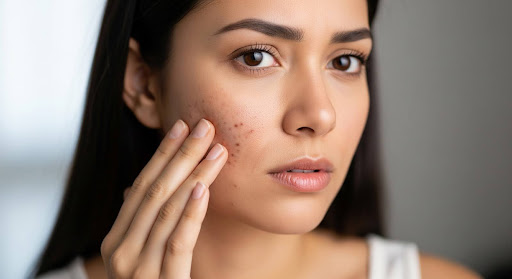Blog
Blue Light & Your Skin: Why Screens Might Be More Than Just Eye Strain

We live in a screen-lit world. From our phones to laptops to that overhead office monitor, we’re bathed in more artificial light than ever. But do we really stop and think about what that light is doing to our skin?
In this post, we’ll take a deep dive into blue light (sometimes called HEV light), how it might affect your skin, what the science says, and ways to keep your skin flawless in the digital age.
What Is Blue Light (and Where Does It Come From)?
Blue light is part of the visible light spectrum (roughly 400–500 nm). The sun produces loads of it naturally, but in modern life, a lot of our exposure comes from artificial sources: computer screens, tablets, smartphones, LED lighting, TVs, and more.
That means even when you’re sitting indoors, reading on your phone or working on your laptop, your skin is still being hit by blue light, though at lower intensities than sunlight.
Now, that raises some questions: Does computer screen damage skin? Does cell phone skin damage happen over time? And is blue light always harmful, or could there be benefits as well?
How Blue Light May Affect Your Skin
Oxidative Stress & Free Radicals
One of the main concerns is that blue light can lead to oxidative stress, meaning it can help generate free radicals in your skin. These unstable molecules can damage cellular components (lipids, proteins, DNA). Over time, that kind of damage contributes to signs of ageing: fine lines, loss of firmness, and dullness.
Collagen Breakdown & Skin Ageing
Some lab studies suggest that blue light exposure can accelerate the breakdown of both collagen and elastin in the dermis, which means your skin’s structural support starts to weaken. That can lead to sagging, more visible wrinkles, and overall blue light skin ageing.
Pigmentation & Dark Spots
Blue light might worsen pigmentation issues, especially for deeper skin tones. Evidence is emerging that it can stimulate more melanogenesis (pigment production) than you might expect, which means dark spots, uneven tone, and post-inflammatory hyperpigmentation might become worse.
So yes, blue light damage to skin is not just a buzz phrase. While it’s not at the level of UV damage, over time and with repeated exposure, it can be a contributing factor to skin ageing and discolouration.
Does Your Computer or Phone Screen Really Damage Your Skin?
Let’s tackle this head-on: Does a computer screen damage skin? There’s no unanimous answer yet, but the emerging body of research suggests that over time, yes, low-level damage is possible, especially when paired with other skin stressors (sun, pollution, lack of antioxidants).
Because screens are so close to us, especially mobile phones, which are held inches from our faces, cell phone skin damage is a real concern. Think about it: your cheek might spend hours pressed against a glowing surface. That prolonged exposure increases the dose of blue light your skin sees.
Still, it’s important to keep perspective: screens don’t emit the same intensity of light as the sun, and blue light is less energetic than UV. So screens are unlikely to be the primary cause of skin ageing, but they may be a sneaky contributing factor.

Is Blue Light Always Bad? (Yes, There Are Exceptions)
Can blue light be good for skin? The truth is, in a few controlled, clinical uses, yes. Dermatologists sometimes use blue light therapy to target acne-causing bacteria. Blue light (especially in higher medical intensities) can help reduce Propionibacterium acnes (P. acnes) and inflammation in acne lesions.
But that’s in a very different context: concentrated, medical devices, short-term exposure under supervision. That doesn’t translate to your smartphone being good for your skin. It’s more like a pro tool, not your daily routine.
In short, for everyday screen exposure, the risks (however mild) outweigh any incidental benefits.
Smart Ways to Protect Your Skin from Blue Light
You don’t need to lock your devices away, but you do need a few smart strategies to shield your skin. Here are ways to defend your skin barrier in our screen-heavy world:
1. Invest in a Blue Light Screen Protector
Yes, just like you protect your eyes with filters, you can protect your screens. Blue light screen protectors (for phones, tablets, monitors) reduce the amount of high-energy visible (HEV) light emitted. They block or filter a portion of the harmful spectrum, lowering the dose your skin receives.
2. Use “Blue Light Blockers” in Skincare
In skincare speak, we call “blue light blockers” those ingredients or formulas that help neutralise or counteract the damage. These are usually antioxidants (vitamin C, ferulic acid, niacinamide, resveratrol, green tea polyphenols), barrier-supporting ingredients (ceramides, lipids), and sometimes physical filters (zinc oxide, titanium dioxide) that also reflect visible light.
Apply these in the morning routine, especially on exposed areas like the face, neck, and hands.
3. Take Screen Breaks & Adjust Settings
- Use the 20-20-20 rule: every 20 minutes, look at something 20 feet (~6 meters) away for 20 seconds. This gives both your eyes and your skin a rest.
- Lower screen brightness, enable “night mode” or “warm mode” (reds and amber tones) during evening hours.
- Increase distance: move your laptop or tablet further away; hold your phone slightly away from your face.
4. Layer an SPF + Antioxidant-Rich Routine
Don’t forget that blue light isn’t the only enemy. UV rays and pollution still cause the bulk of daily damage.
- Use a broad-spectrum sunscreen every morning (yes, indoors too), many modern ones include filters that help reflect or block visible light.
- Layer antioxidant serums underneath your SPF.
- At night, focus on repair: retinols, hydrating serums, barrier-repairing moisturisers.
5. Mind Your Environment & Habits
- Dim overhead lights; avoid harsh fluorescents.
- Use warm (non-LED) ambient lighting in the evening.
- Use protective shields or films for indoor lighting if possible.
- Get adequate sleep. Blue light also messes with your circadian rhythm, which affects skin recovery.
Why This Matters (Especially for Melanin-Rich Skin)
If your skin is richly pigmented, you might already be more attuned to pigmentation, dark spots, and uneven tone. Blue light’s potential to stimulate melanogenesis means that protecting your skin in this context is particularly important. Even small triggers of hyperpigmentation can leave long-lasting marks in deeper skin tones.
By using smart protection strategies and bolstering your skin barrier, you reduce the risk that screen time will aggravate dark spots or post-inflammatory hyperpigmentation.
Final Thoughts: Be Screen Smart, Skin Safe
Blue light might not burn like UV rays, but its constant presence can quietly stress your skin, accelerating ageing, pigmentation, and dullness. The solution isn’t to fear your screens, but to protect your skin wisely.
Pair your sun protection with antioxidant-rich “blue light blockers,” invest in a screen protector, and build mindful tech habits. Remember that conscious beauty means adapting to the world we live in, helping your skin stay resilient, radiant, and ready for anything, on-screen or off.

